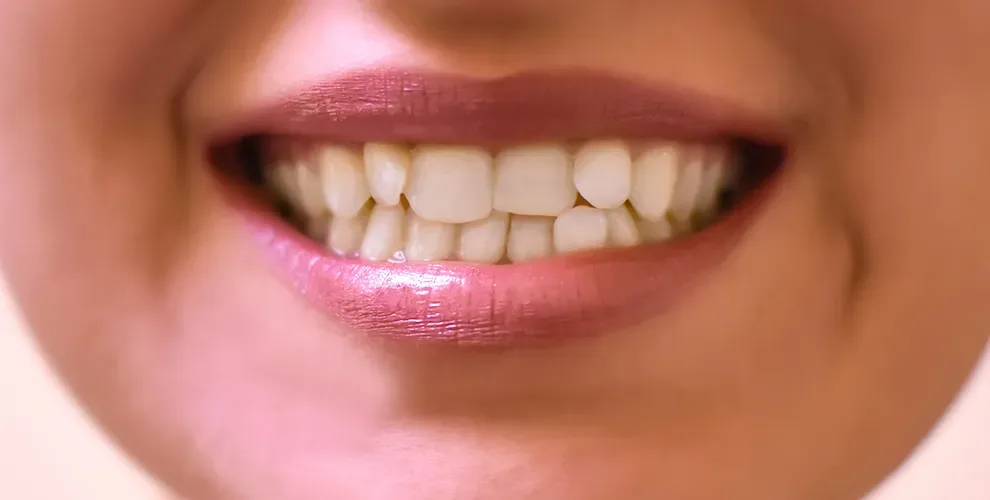The Most Common Types of Crooked Teeth

Table of Contents
- History
- Different Types
- Factors Influencing Crooked Teeth
- Cause Problems
- Treatment Options
- Crooked Teeth FAQs
- References
There are many different types of crooked teeth.
Bite issues, such as overbite or underbite, are categorized from mild to severe. Crossbites, open bites, and deep bites are additional types of bite problems.
Crowding, spacing, and protrusions also lead to crooked teeth.
A History of Misaligned or Crooked Teeth
Our jaws have evolved over time, becoming smaller as we eat more cooked foods and use utensils to divide food into bites. As our jaws have become smaller, our teeth have not changed much. This is why modern humans still have third molars, or wisdom teeth, for example.
Other problems are common due to our now smaller jaws, including misaligned teeth.
Genetics determine how much you will struggle with crooked or misaligned teeth throughout your life. Some people might never need braces or aligners, or they might not need them for long. Others may need to return to orthodontic treatment throughout their lives.
Different Types of Crooked Teeth
There are three basic types (classes) of malocclusion.
All three classes of malocclusion may feature the following:
Crowding: There is insufficient space in the jaw for all the teeth. This makes teeth harder to clean, increasing the risk of cavities and other oral hygiene issues.
Spacing: There is a lot of space between the teeth. Food can get stuck in open areas, which can lead to cavities and gum disease.
Tooth rotation: Some teeth are twisted or rotated.
Crossbite: This occurs when upper teeth fit inside lower teeth, so the lower jaw overlaps them. This can cause the jaw to shift to one side, making jaw pain more likely.
Open bite: Anterior open bites occur when the back teeth are together, but the front top and bottom teeth do not overlap. Posterior open bites occur when the front teeth meet but the back teeth do not. This can cause problems swallowing, tongue thrusting, and some speech problems, in extreme cases.
These are the three classes of crooked teeth (malocclusion):
Factors Influencing Crooked Teeth
While genetics largely determine the alignment of your teeth, some lifestyle factors can influence their alignment as well. These include the following:
Childhood habits, such as thumb sucking, tongue thrusting, and prolonged use of a pacifier or bottle
Having extra teeth like wisdom teeth for a long time, impacted teeth, abnormally shaped teeth, or losing teeth
Oral hygiene issues
Dental fillings, crowns, implants, appliances, braces, or retainers that do not fit
Misaligned fractures after an injury, surgery, or tumor
Teeth shifting after a lost tooth
Jaw conditions
Teeth grinding
When do Crooked Teeth Cause Problems with your Oral Health?
To understand the effect that malocclusion and crooked teeth can have on your oral health, the following factors need to be considered:
The build-up of harmful bacteria in the mouth (including plaque) can cause tooth decay and gum problems. These are two major causes of oral health issues. Malocclusion often involves crowding and spacing issues, which can both make teeth harder to clean and increase the risk of decay and gum irritation. With crowding, teeth are close together. The areas between them may be very narrow and hard to reach while cleaning. When there’s gaps between teeth, the space left in the gums can accumulate bacteria and (bacteria-feeding) food particles.
Crooked teeth and bite problems can create harmful bite patterns. For example, a top molar might brush against a bottom molar in an unnatural way, and this can cause wear and tear on the tooth, weakening the enamel and making it more prone to decay or damage. A bad bite pattern could also affect the gums. If a tooth is coming up against a part of the gums and causing friction, it could result in gum irritation and inflammation.
When crooked teeth are caused or related to a jaw issue, it can put strain on the jaw and surrounding muscles.
Ultimately, crooked teeth (malocclusion) can cause a variety of oral and general health problems if left untreated. These are some of the problems that may occur:
Tooth decay (including cavities)
Gum problems (inflammation or swollen gums)
Gum disease
Jaw disorders, including TMJ (temporomandibular joint disorders)
Jaw and muscle strain
Headaches
Neck pain
Problems speaking
Problems chewing and biting into food
Dry mouth
Self-consciousness, possibly affecting confidence and mental health
Treatment Options for Different Types of Crooked Teeth
Your treatment options will depend on what kind of crooked teeth you have, what’s causing the malocclusion, and how severe it is.
